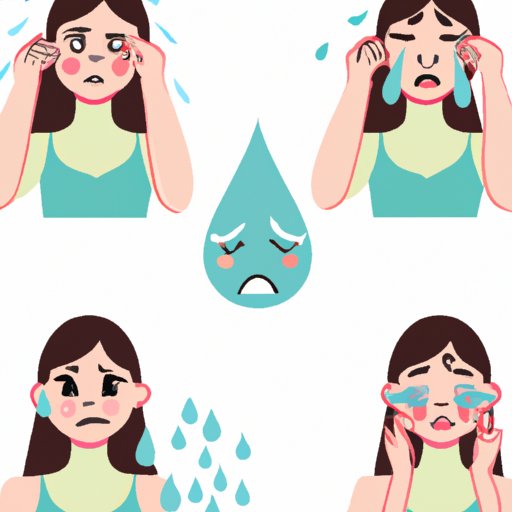Introduction
Crying is a natural response to emotion, whether it be joy, sadness, or something in between. It’s an important part of the human experience, and can help us process and release difficult feelings. But what does crying do to our skin? In this article, we’ll look at how crying affects our skin health, from the physical and emotional effects to the potential benefits, and how to protect your skin while crying.
How Crying Affects Your Skin
Crying can have both physical and emotional effects on your skin. The physical effects include redness and puffiness around the eyes, as well as increased sensitivity. This is because tears contain salt and other chemicals that can irritate the delicate skin around the eyes. Emotionally, crying can leave you feeling drained, which can lead to further skin irritation due to lack of sleep and stress.
Benefits of Crying for Skin Health
Despite the potential physical and emotional side effects, there are some potential benefits of crying for your skin health. These include:
- Improved mental health: Crying can help reduce stress levels and improve mood, which can have a positive effect on your overall skin health.
- Reduced stress levels: Stress can cause inflammation and breakouts, so reducing stress through crying can help keep your skin looking its best.
- Decreased inflammation: Tears contain natural anti-inflammatory properties, which can help reduce redness and swelling.

How to Protect Your Skin While Crying
Although crying can have some potential benefits for skin health, it’s still important to take steps to protect your skin while crying. Here are some tips to help keep your skin healthy while crying:
- Use a soft, clean tissue to wipe away tears: Tissues can help absorb excess moisture and prevent the salt in tears from irritating your skin.
- Avoid rubbing or touching your face: Rubbing and touching your face can spread bacteria and aggravate existing skin conditions.
- Rehydrate your skin after crying: Rehydrating with a gentle moisturizer can help replenish lost moisture and keep your skin looking healthy.
What Happens When You Cry Too Much?
While occasional crying is normal and can even be beneficial for your skin, excessive crying can have some negative effects. These can include:
- Dehydration: Excessive crying can lead to dehydration, which can cause dryness and flakiness.
- Redness and swelling: Teary eyes can lead to redness and puffiness around the eyes, which can be uncomfortable and unattractive.
- Breakouts: Crying can increase oil production in the skin, which can lead to breakouts.
The Best Skincare Products for After Crying
To help soothe and protect your skin after crying, here are some of the best skincare products to use:
- Gentle cleansers: Look for cleansers with mild ingredients that won’t strip away essential oils from your skin.
- Moisturizers: Choose a moisturizer that’s free of fragrances and dyes, as these can further irritate sensitive skin.
- Eye creams: Eye creams can help reduce puffiness and dark circles caused by crying.

Crying and Its Effects on Acne
Crying can also have an effect on acne. Tears contain oil and salt, which can increase oil production in the skin, leading to more breakouts. Additionally, tears can create a moist environment that’s ideal for bacteria growth, which can further aggravate existing acne. Finally, excessive crying can lead to redness and swelling, which can increase the risk of scarring.

Understanding the Link Between Stress and Skin Issues
It’s important to understand the link between stress and skin issues, as stress can exacerbate existing skin concerns. Stress hormones such as cortisol can increase inflammation in the body, leading to flare-ups of skin conditions such as eczema and psoriasis. Stress can also lead to decreased immune system function, which can make skin more vulnerable to infection. Finally, stress can disrupt the balance of bacteria in the skin, leading to breakouts.
Conclusion
In conclusion, crying can have both physical and emotional effects on your skin. While occasional crying can have some potential benefits, it’s still important to take steps to protect your skin. This includes using a soft, clean tissue to wipe away tears, avoiding rubbing or touching your face, and rehydrating your skin afterwards. Additionally, excessive crying can lead to dehydration, redness and swelling, and breakouts. To help soothe and protect your skin after crying, use gentle cleansers, moisturizers, and eye creams. Finally, it’s important to understand the link between stress and skin issues, as stress can exacerbate existing skin concerns.


